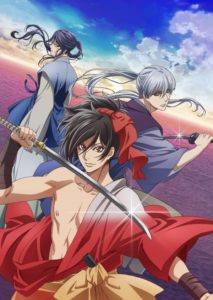![]() Thrust into a different world, Zed finds himself full of power but also full of teenage emotions and actions as he tries to find his place there.
Thrust into a different world, Zed finds himself full of power but also full of teenage emotions and actions as he tries to find his place there.
What They Say
In a dystopian future, two friends dream of freedom… and gain more than they bargain for! Hothead Zed is on the run from the authorities, while his brainy pal Noah struggles with his own battered body. Both find a magical world that seems to offer escape and power undreamed of. But at what price?
The Review!
Audio:
The audio presentation for this release brings us the original Japanese language track in stereo along with an English language dub, both of which are encoded at 224kbps. The show has some rather good moments when it comes to the action across the forward soundstage with some decent directionality and a fair bit of impact as the spirits fight. Kiba has a fair mix of action and dialogue and the dialogue pieces are well served as well as there’s some noticeable placement and directionality at times as well as a few moments of noticeable depth as well. Dialogue is clean and clear throughout and we had no problems with dropouts or distortions during regular playback.
Video:
Originally beginning its broadcast run in 2006, the transfer for this TV series is presented in its original full frame aspect ratio. This set contains fifty-one episodes spread across eight discs the same as they were in the two previous sets. There’s no difference in the discs compared to the previous half series sets released. The show does have a fair amount of material encoded below 5mbps and this mostly comes across alright, but never truly shines. Some of the scenes have more noise than they should, but it never really dominates either. Colors generally look solid and pleasing, though it depends on the setting as the series covers a number of different areas and each one has a distinct look, though most tend to be somewhat drab and dull. The more vibrant areas come across better as the variety of colors really works in its favor. The episode to disc layout isn’t bad, though I would have preferred a little more space overall, even a five-disc format just to give it a little more breathing room.
Packaging:
Kiba is essentially repackaging what came before but ADV Films gets a bit of credit for this release as they use different artwork for this incarnation. The physical packaging is basically identical as the two half-season sets in they’re stackpacks with some foam to help keep it in place on the opposite side. All the discs are stacked on top of each other in each case with four discs in each case. I’m still no fan of these kinds of cases and this release doesn’t change that. Holding the two sets together is a thin cardboard slipcover that gives over the majority of both sides to character artwork. One side features a flame oriented piece with the main trio of characters posing together while the other side goes for a cooler look as it has Zed and Noah back to back almost with a bright glowing city behind them. The two side panels offer up different pieces of character artworks of the leads so you have a choice of which one you want to have face outward.
Inside the slipcover we have the two cases which have different artwork from the previous half sets. The first one has a good shot of Zed in the foreground with streams of green across him while Amira-Gaul is behind him. The second set has Zed and a nemesis of his with a more purple oriented cover which works well in contrast to the first one. The back covers are laid out the same and use the same kind of color schemes to separate them with one being green and one being purple. There are four blocks that break down the episode numbers and titles for each disc which makes it very easy to find. There are a few shots from the show as well focused on character artwork that gives it a little extra push. The bottom section has the usual layout with a listing of the production credits for both sides while also having a clean and easy to read technical grid. These covers are decent overall but it has a sort of basic approach to it that works but doesn’t really win you over in any serious way. No show related inserts are included in this release nor are there any reversible covers.
Menus:
The menu design for Kiba is the same across all four discs as it has a black background with a light character piece of Amir Gaul with his eyes closed as he looks down. The left side features the episode selections going down in an almost rib-like way while the right side has a few selections such as language, credits and extras if available. The layout is quick and easy to navigate and it brings in an interesting piece of artwork from the ending sequence to frame it all, but it doesn’t really do much to set the mood for the show itself, which is pretty much all over the map at times. The submenus load quickly when needed and the discs all correctly read our players’ language presets which continues to be a huge plus in ADV’s favor.
Extras:
The only extras included are clean versions of the opening and closing sequences, which are spread across the discs as opposed to being included on each volume like they do their normal single disc TV releases.
Content:
With fifty-one episodes to the series, spread across eight discs in two collections here, there’s a lot to talk about considering the sheer amount of material. Kiba is not the kind of series that you’d normally expect considering its origins. Produced based on a trading card game which had seen release in the US by Upper Deck, it doesn’t follow the traditional shows of this kind of genre that was blazed by Pokemon. The fighting aspect is there, but it doesn’t dominate each episode and it’s not a tournament based show. And it’s not centered around too-young kids who can live through unbelievable events. Instead, characters do die and there’s a fair bit of brutality brought into it as well. Across these first twenty-six episodes, it doesn’t shy away from some tough things as it presents a rather cruel world.
Kiba takes place mostly on one world, but it starts in another in a place called Calm where we’re introduced to fifteen-year-old Zed and his friend Noah. Zed’s a spunky troublemaker who is being roughed up by just about everyone because of the way he is with his attitude. His school is suffering to say the least and the administration is ready to expel him. If not for his friend Noah advocating for him, and the explanation of his mother being in the hospital and seemingly suffering from mental issues, he’d have been booted awhile ago. But the things he gets into just makes it worse and worse and it’s all coming to a head. Things get so bad in fact that the police are after him now with guidance from the school. The reasons are somewhat hazy at first, but it turns out that Zed is actually someone that is being sought after as one of the teachers is actual a creature called a Tusker that’s intent on killing him. Interestingly enough, the Tusker reference isn’t touched upon again until nearly twenty-episodes later in any serious form.
When Noah works to free him from the police, it causes a chain of events where Zed suddenly finds himself facing a mysterious gateway in front of him. With nothing but trouble behind him, it doesn’t take much for him to take the leap of faith into what’s beyond. And what’s beyond is radically different from where he came from. Calm was an urban city where the wind didn’t blow and it felt completely oppressive. Where he lands is in the midst of a forest where there’s a wonderful breeze and lots of green land and blue skies. He stumbles across a couple of people, people that will be part of his life from here on out, and learns that he’s in a country called Templar. And that he’s something called a shardcaster, a person who is able to manipulate shards that call forth spirits that do battle with other spirits. Zed is uninterested in much of anything when it comes to the country itself, but he finds himself getting caught up in events as he hangs out with the old master named Zico and his pupil, a girl named Roya.
Zed’s story is admittedly somewhat predictable here as he goes through getting a decent understanding of the world and how the shardcasters fit into it. Templar is a rather straightforward fantasy country where people are generally good but there’s an undercurrent of danger to things as they’re the kind of country that seeks some general balance among all the nations. Some of those that he meets are good, like Roya and her friend Mickey, others are arrogant and snobbish like Robes, a shardcaster who feels he’s above all others because of his titles and status. But he also finds some less than savory elements, such as a man named Dumas who is from the country of Zymot where might makes right and almost anything goes in the quest to be the best. The introduction of Dumas as this kind of character brings in something a bit darker as he’s intent on having revenge for his status in Zymot and he’ll do whatever he has to in order to achieve it.
The one character that he meets early on that goes through the most changes though is a young woman named Princess Rebecca. Part of the royal family of Zymot, she’s in hiding as her father was killed and his subordinate named Hugh has been manipulating things in order to take power. He requires Rebecca however in order to gain one of the most powerful of spirits so he’s working various plans to bring her in to him. With her as the figurehead leader of the resistance, she’s key to events that are going on in Zymot and she ends up stumbling into Zed’s hands at one point. Rebecca goes through the most changes as she’s fairly meek and mailable when we first meet her, but events force her to grow up and make hard choices. Enough so that she starts to swing heavily towards the other end of the spectrum as she intends to take back her fathers’ kingdom.
For the first ten or so episodes, the focus is on Zed and his adventures once he gets to Templar and involved with all of those there as he figures out how the world works. What was appealing was the change around this time where we find out that Zed wasn’t the only one that crossed over. Noah has found himself dropped into this world as well and he’s in for a more disturbing adventure. Noah’s the calm and quiet type, but one with a real problem as his body is close to ceasing to function because of an illness. With help from what’s basically a body brace that accelerates his death but allows him to live normally until then, he ends up in the land of Neotopia. An awful name, but a fascinating land where the Absolute Law is in effect. The country has very strict rules and laws and the penalty for many things is instant death. The flip side is that because of this, the majority of people are very well off and happy and willing to give their lives should they break the law because they know how good they have it.
This is very disturbing for Noah, especially as the people who took him in get in trouble because they didn’t file notice that he had arrived from another world. The life that Noah leads on this world is complicated as he ends up thrust around into different areas and with different groups before finally landing at the seat of government in Neotopia where he becomes someone who fully believes in the Absolute Law that rules the land. With the special skills that he brings to the picture, similar to the kind of above the norm things that Zed does, Noah becomes a key player in this country and he takes on the role with relish. But he’s not lost who he is in a way as he doesn’t view Zed as the enemy when they meet. In fact, he views what he’s doing as a way to live out his life the best he can and repay people for what they’ve done for him, and that includes Zed.
Thankfully, the tournament aspect of the series which it starts to deal with about halfway through the show doesn’t really run all that many episodes. The tournament helps to set up the rivalry between Zed and Noah and the different belief systems that they have. But it also starts to push some of the jealousy issues that Noah has had all these years with Zed and the issues he had. The matches go rather quickly and I was surprised to see Robes pretty much pushed out of the picture during this event. Of course, he does it with wine and women. If there’s an area that bothered me here, it was the revelation that the Holy Father Hyrum founded Neotopia ten years prior. That’s a whole lot of changes for a nation, especially when you consider how devoted many of the citizens are in regards to the Absolute Law.
What else the tournament sets up is the imminent invasion of the nation by Hugh as he uses the nation of Tusk in his plans. The Tusks simply want to bring about the return of the Great Tusker so they have little issue in having Hugh becoming involved. With the Great Tusker, the belief is that once brought back into the world, their patron deity will turn their nation into a wonderful place and everything will be better. With the mythology behind the Great Tusker somewhat vague, it also has strong ties to the origins of the shards. Kiba does a decent job in adding more to its back story overall here but it gets caught up in the big event of having nations going against nations and a lot of little elements coming into play about how each nation operates. Neotopia is put under a microscope here in a lot of ways, from Roya getting arrested for doing good to the reasons behind Ulvarx wanting to take down Neotopia.
Kiba spends a good part of its final run of episodes upping the stakes nicely as another group that’s been in the shadows appears with their own agenda for destroying the world. The Seekers do feel like they come out of nowhere but they bring in some interesting angles to it, from Sagiri being sought out after she becomes a Savior and the changes that Noah goes through during his time off screen for awhile. The big element that comes into play during the end run, besides the obvious eventual final battle with the fate of the world in the balance, is that we get the back story for who Sarah is and how Zed became to be considered the savior worthy of Amir Gaul. It’s a little convoluted, and I would have preferred a bit more time given to his father, but there’s a lot to like with how this aspect of the series fits into everything.
One of the things that did keep me guessing with the show was the way it had no problem in killing off characters. Even in most series like this, the secondary characters and the “red shirts” often don’t really get hurt, but here they do suffer, sometimes very much so. Whether in the tournament fights or in the full-on war sequences, there’s a certain element of uncertainty for most of the cast as to whether they’ll survive it. Death isn’t a great thing but having it so that each character isn’t really safe from this particular change and how it could alter the story gives it a bit more edge. The downside that I had for this half of the series is that the final run of episodes, once the Seekers are introduced, feels a bit too forced. Perhaps I missed some of the mention of them earlier in the show but it was something that felt like it was out of place on the dynamic changed after Hugh’s war on Neotopia.
In Summary:
With the origins of the show and how much it could have gone into things most card game based shows do, there’s a lot to like about Kiba. Very few shows in this area really manage to stand out as little more than cloying kiddie fare but Kiba plays things to an older audience and doesn’t treat them with completely predictable pablum. Madhouse did a good job keeping it vibrant and fluid through it with the animation and with plenty of variety for all the designs. It didn’t feel like a cheap budget production, but it didn’t feel like a top of the line one either. With the story, it’s got a lot going on here and there are some big problems here and there with the design of it – and the passage of time as well – but the overall series was a lot of fun. I had low expectations to begin with but it kept me entertained throughout and it did avoid a lot of the pitfalls of the genre as well. For the price and amount of episodes you get, it’s certainly an easy show to give a spin and check out.
Features
Japanese 2.0 Language, English 5.1 Language, English Subtitles, Clean Opening, Clean Closing
Content Grade: B-
Audio Grade: B+
Video Grade: B+
Packaging Grade: C
Menu Grade: B-
Extras Grade: B-
Released By: ADV Films
Release Date: October 13th, 2009
MSRP: $59.98
Running Time: 1275 Minutes
Video Encoding: 480i/p MPEG-2
Aspect Ratio: 1.33:1
Review Equipment:
Sony KDL70R550A 70″ LED 1080P HDTV, Sony PlayStation3 Blu-ray player via HDMI set to 1080p, Onkyo TX-SR605 Receiver and Panasonic SB-TP20S Multi-Channel Speaker System With 100-Watt Subwoofer.













 新キャラクター&キャスト公開⑦
新キャラクター&キャスト公開⑦














